A different ‘Explore’ this month, with August heat heading for 40c, and a trip over to the north coast to visit the ruined city of Aptera. Most visitors to Chania, and on over to Paleochora, will arrive in Crete through the airport at Daskalogiannis, or on the overnight ferry from Piraeus. Both might give a glimpse of Aptera, and the imposing Turkish fortress, high above Souda Bay.
Aptera is situated 17km east of Chania along the national road, taking the exit to Megala Horafia, climbing steeply up into the village, then a left turn to the archeological site. Once through the village there’s a parking space, information boards, and the first view of the cyclopian walls which surrounded the city, enclosing an extensive area of c.1000m from east to west, c.700m north to south. Aptera’s existence occurs in the Linear B tablets, evidence that there was a settlement here in the 14th/13th centuries BC, from when it grew to be one of the most important city states of Crete. Recent excavations show the road leading to the main entrance, with rock-cut tombs nearby.
From here, drive on – or better still walk above on a walled track – to the main area of Aptera.
The city reached its peak during the early Hellenistic period (end 4th/3rd cent. BC) when it flourished as an economic and political centre, minted its own coins, developed diplomatic relations and forged a substantial trading network throughout the Hellenistic world. It’s two harbours either side of Souda Bay, at Kissamos (now Kalives) and Minoa (now Marathi on the Akrotiri) gave control of naval activities. Jurisdiction as a city state included Akrotiri, Apokoronou, the islands of Souda Bay, and as far west as Kydonia (now Chania.) With an estimated population of 20,000, of which a fifth were “freemen”, merchants, land and ship-owners, and the remainder slaves, Aptera continued to develop.
Further prosperity came under the Roman occupation (69BC – 365AD) when Aptera signed the “Pax Romana”, along with Polyrhenia, Gortys and other city states. Habitation continued through the early Byzantian period, but following a destructive earthquake in the 7th century, and the subsequent Saracen invasion and destruction, Aptera was abandoned as a city.
Much of the main area is fenced off, as excavations are ongoing, including access to a Doric temple and amphitheatre to the south. The two Roman cistern complexes, one superbly three-vaulted, can be admired from the perimeter fencing, but admission to the Monastery of St. John the Theologian, and a closer walk around the ruins, is limited to Tues/Sun, 8am – 2pm. As with many similar ancient sites, imagination (and some wonderment) is required when exploring here, treading in the footsteps of ancient Greeks, Minoans, Mycenaeans, Dorians, Romans, Saracens, Venetians and Germans, all of whom have played a part in Aptera’s long history.
Further on, and where the road ends, is the substantial Turkish Fortress, built after the Cretan revolt of 1866, and using much material taken from Aptera. There’s no access, but it’s a superb viewpoint over Souda Bay, Apokoronou, and inland to the high peaks of the White Mountains. Far below is the Itzedin Fortress at Kalami, also Turkish, once used to hold political and other prisoners. With no shade at Aptera, a morning visit is advisable, or wander around the site at sunset, and enjoy a meal afterwards at one of the tavernas in the nearby village.
Footnote
Readers of our “Ten Walks” and “More Walks from Paleohora” – the former recently revised and re-published in memory of Lynne – will know of the contributions to the descriptions of Lissos, Kadros and Viena by our friend Tony Fennymore. After Tony died in England in 2007, his family and friends brought his ashes to Crete, and were buried at Aptera, his favourite place, and about which he knew more than probably anyone.

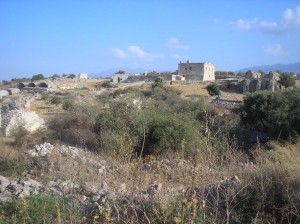

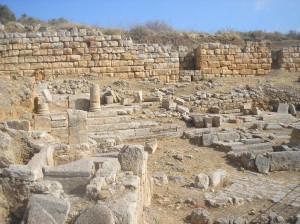
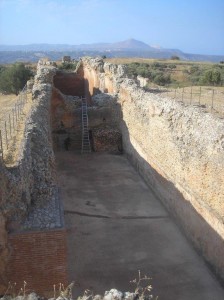
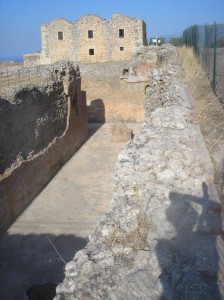
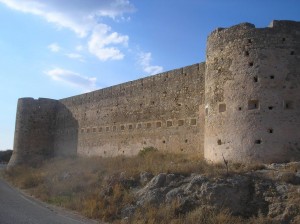

1 comment
For more information about the ancient city of Aptera check out http://www.just-crete.co.uk